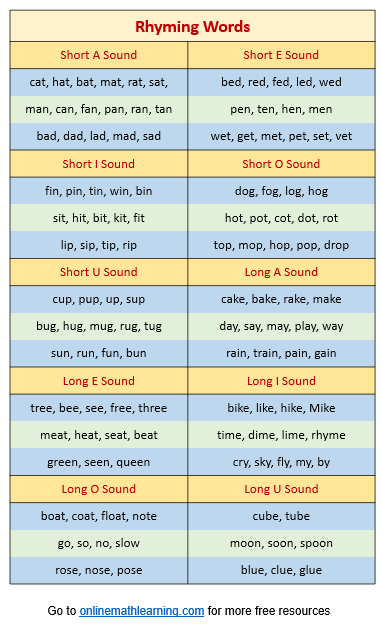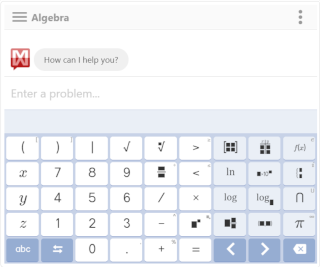Rhyming Words
Videos and songs to help Kindergarten and First Grade kids learn how to rhyme.
Learning rhyme is important for young children to develop their language and literacy skills.
Rhyme helps children notice and distinguish the individual sounds (phonemes) within words. This is a fundamental skill for reading and spelling. By hearing that “cat,” “hat,” and “bat” sound similar, children begin to break down words into their component sounds.
The following diagram gives some rhyming words for kids, categorized by sound to make it easier to learn and play with them. Scroll down the page for more examples.

Other Useful Rhymes:
ball, tall, small, call
car, far, star, jar
book, look, cook
house, mouse
bear, hair, chair
night, light, right
round, found, sound
thing, sing, king
Teaching rhymes to kids can be a lot of fun.
- Start with Listening and Recognizing:
Sing rhyming songs and nursery rhymes: These are excellent for introducing rhythm and rhyme.
Examples: Twinkle Twinkle Little Star, The Wheels On The Bus
Read rhyming books aloud: Choose books with strong, clear rhymes and emphasize the rhyming words as you read.
Examples: Dr. Seuss books
Point out rhymes in everyday speech: When you hear rhymes in conversations or songs, point them out to the child. “Did you hear that? ‘Cat’ and ‘hat’ rhyme!"
Clap or tap to the rhythm: This helps children feel the rhythm and pattern of rhyming words.
-
Identifying Rhyming Words:
“Do these words rhyme?” game: Say two words and ask the child if they rhyme. Start with simple, clear rhymes like “cat” and “hat,” then gradually introduce more challenging ones.
Rhyme sorting: Use picture cards or objects. Have the child group together items that rhyme (e.g., pictures of a cat, hat, and bat).
Thumbs up/thumbs down: Say two words. If they rhyme, the child gives a thumbs up; if they don’t, they give a thumbs down. -
Producing Rhyming Words:
“What rhymes with…?” game: Say a word and ask the child to think of words that rhyme with it. Start with simple words and provide hints if needed.
Fill in the blank rhymes: Provide a simple rhyming sentence with a missing word and have the child fill it in. “The cat sat on the ____."
Rhyming chains: Start with a word and have the child say a word that rhymes with it. Then, the next person says a word that rhymes with the previous word, and so on. For example: cat → hat → bat → sat.
Tips for Teaching Rhymes to Kids:
- Keep it fun and playful: Use games, songs, and activities to make learning enjoyable.
- Use visuals and actions: Pictures, objects, and actions can help children understand the concept of rhyming.
- Start with simple words and sounds: Begin with common, one-syllable words with clear rhymes.
- Be patient and encouraging: Learning to rhyme takes time and practice.
- Exaggerate the rhyming sounds: When reading or singing, emphasize the rhyming parts of the words.
- Connect to phonics: Rhyming is closely linked to phonemic awareness (understanding the sounds in words), which is a crucial pre-reading skill.
I Love to Rhyme - English Song for Kids
The song will give the first two words that rhyme and then you are asked to generate the third rhyming word on your own.
Rocco the Rhyming Rhino - Rhyming Song for Kids
Rocco gives 2 rhyming words in the beginning of this song.
Then, Rocco will give the first rhyming word and you fill in the other rhyming word.
See how many words you can think of that can rhyme with Rocco’s word.
The Rhyming Words Game - Rhyming Song for Kids
The song gives you two words that rhyme and you have to determine which of the next words it gives you rhyme with the first two. If the word doesn’t rhyme sit down, if the word rhymes stand up.
Rhyming Words
Recognize and produce rhyming words.
Rhyme Time
What words do you know that rhyme?
Learning Phonics
| Short Vowels | ||
|---|---|---|
| Short A | Short E | Short I |
| Short O | Short U | Short Vowels |
| Long Vowels | ||
|---|---|---|
| Long A | Long E | Long I |
| Long O | Long U | Y (vowel) |
| Long Vowels | Short, Long Vowels | Rhyming Words |
| Short & Long Vowels | ||
|---|---|---|
| Short & Long A | Short & Long E | Short & Long I |
| Short & Long O | Short & Long U | Short I & Long E |
The following printable worksheets can be used to practice writing CVC words while reinforcing reading.
| Free Printable Worksheets (CVC Words) | |
|---|---|
| Set 1 Match CVC Words Write CVC Words Match & Write Spell CVC Words Sort CVC Words |
Set 2 Match CVC Words Write CVC Words Spell CVC Words Sort CVC Words Match Phrases |
| Set 3 Match CVC Words Write CVC Words Spell CVC Words Sort CVC Words Match Phrases |
CVC, CCVC or CVCC Match Words Write Words |
| Consonant Digraphs | ||
|---|---|---|
| CH Sound | SH Sound | Soft TH |
| Hard TH | WH Sound | PH Sound |
| GH Sound | NG Sound | Consonant Digraphs |
Free Printable Worksheets for Consonant Digraphs
These worksheets focus on the consonant digraphs: ch, sh, th, qu and ng.
| Printable Worksheets (Consonant Digraphs) | |
|---|---|
|
Learning "ch" |
Learning "sh" |
|
Learning "th" |
Learning "qu" |
|
Learning "ng" |
|
Free Printable Worksheets for Digraphs
| Printable Worksheets (EE, OO, OU, OI, AW) | |
|---|---|
|
EE Words |
OO Words |
|
OI Words |
AW Words |
Types of Verbs
Action Verbs
Is, Am, Are
Has, Have
Spelling Rules for Verbs
Adding -ed
Irregular Verbs
Adding -ing
Try the free Mathway calculator and
problem solver below to practice various math topics. Try the given examples, or type in your own
problem and check your answer with the step-by-step explanations.

We welcome your feedback, comments and questions about this site or page. Please submit your feedback or enquiries via our Feedback page.